Compact ultra-wideband monopole antenna with dual-band notched function
SHI Hong-yan, TENG Fei, LIU Lu-lu, GAO Fei
(College of Information and Electrical Engineering, Shandong University of Science and Technology, Qingdao 266590, China)
0 Introduction
With the rapid development of wireless communication technology, more and more attention is paid to ultra-waveband (UWB) technology.Especially for UWB antenna, it is the important element to decide the performance of the system., so it is of theoretical and practical value to study UWB antenna.An extremely wide spectrum of 3.1-10.6 GHz for UWB communication released by Federal Communications Commission in 2002 has overlaps with wireless area networks (WLAN) 5.5 GHz (5.15-5.83 GHz) and worldwide interoperability for microwave access (WiMAX) 3.5 GHz (3.30-3.70 GHz), thus it is necessary to design UWB antenna with notched function in proper frequency band to avoid interference between the systems.
Kerkhoff designed UWB monopole antenna with notched function in 2003.Later, Schantz H G and Lee W S also proposed a kind of printed antenna with notched function, explaining the relationship between notched frequency and slot size.Generally, the total length of slot is equal to a half or a quarter of waveguide wavelength that is relevant to notched center frequency.In this paper, we propose a monopole antenna program with notched function in WiMAX 3.5 GHz and WLAN 5.5 GHz.
In Ref.[1], a compact fork-shaped monopole UWB antenna with notched function was proposed, with size of 50 mm×24 mm×1.6 mm, and a symmetrical L-shaped slot was made on the ground in top left and top right corners.After adjusted the size of L-shaped slot and fork-shaped patch, the antenna can realize notched function at 2.4 GHz and 5.5 GHz.By analyzing notched principle in Refs.[1] and [2], we design a miniaturization, low cost and compact dual-band notched antenna by adopting annular monopole antenna model in Ref.[1] and design formulae for relative dielectric constant in Ref.[2].After adjusted parameters about C-shaped, L-shaped slots and other parts on the ground, the antennaed realizes notched function at WiMAX 3.5 GHz and WLAN 5.5 GHz perfectly.Compared with the antenna in Ref.[1], antenna proposed in this paper has several differences: ① Different size.The size of antenna here is much smaller, 36 mm×24 mm×1.6 mm.② Different notched frequency.The range here is between WiMAX 3.5 GHz and WLAN 5.5 GHz.③ Differenct design formulae for calculating effective dielectric constant.
1 Design of antenna
The geometry of the proposed antenna is shown in Fig.1 and Fig.2.The substrate material is FR4, relative dielectric constant isεr=4.4, and loss tangent is tanθ=0.02.The antenna with geometric size of 36 mm×24 mm×1.6 mm is fed by microstrip line with characteristic impedance of 50 Ω.There are symmetrical L-shaped and step-shaped slots in top left and top right corners[3-11].
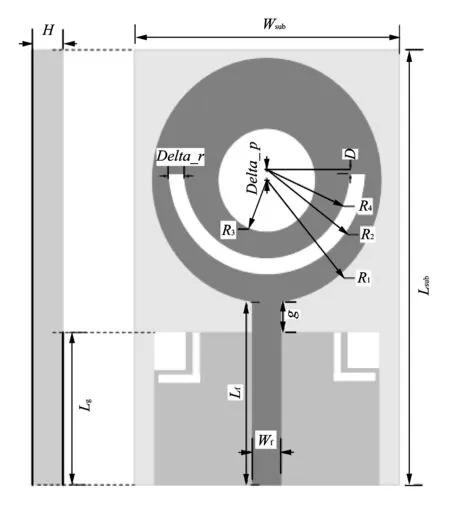
Fig.1 Model of notched antenna
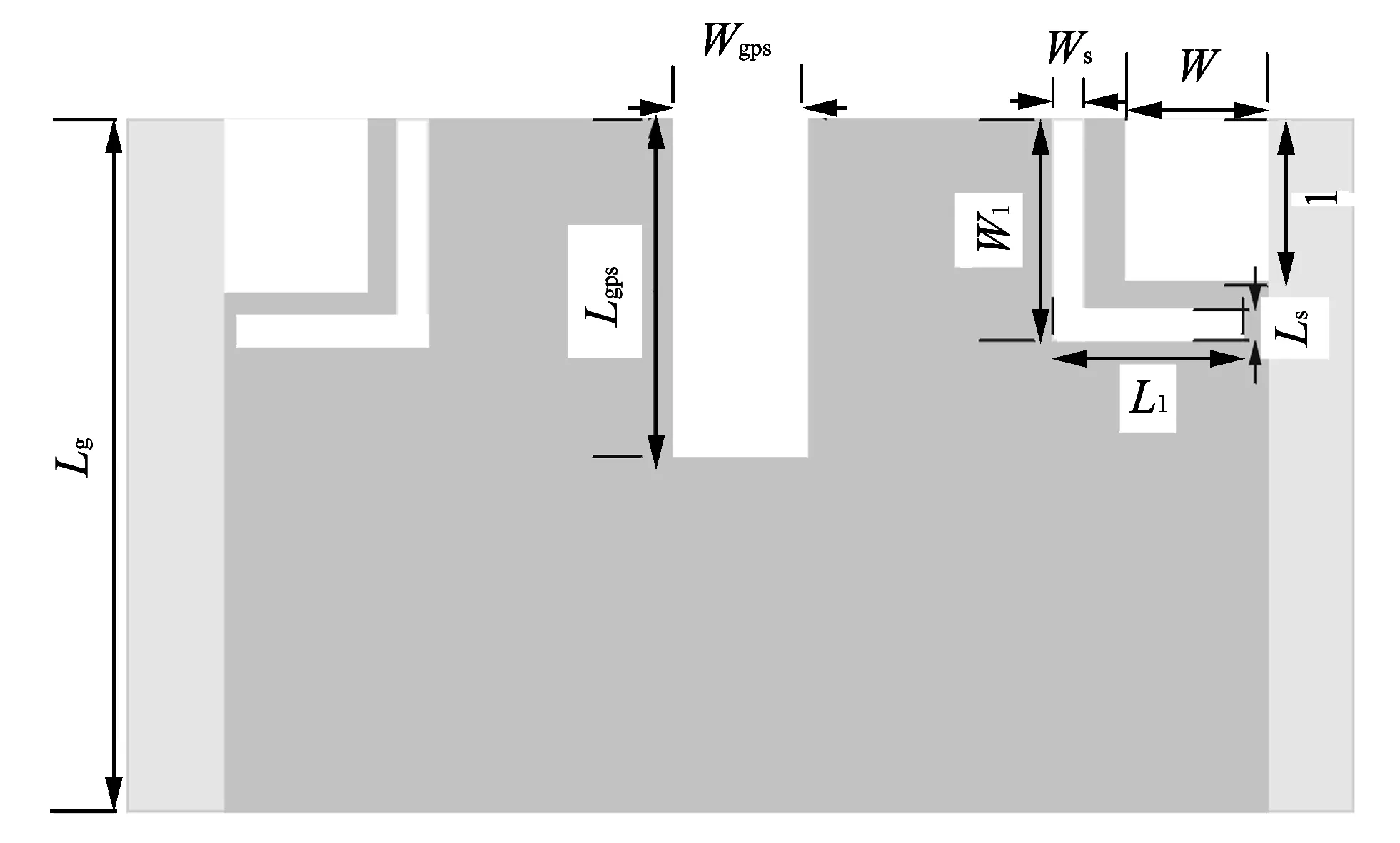
Fig.2 Ground model of notched antenna
The length of C-shaped slot is
(1)
Notched frequency realized by C-shaped slot is
(2)
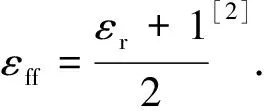
The total length of L-shaped slot is
ML=Wl+Ll-Ws/2.
(3)
Notched frequency realized by L-shaped slot is
(4)
By continually simulating and optimizing the antenna with commercial software ANSOFT HFS, we can get the optimum parameters shown in Table 1.
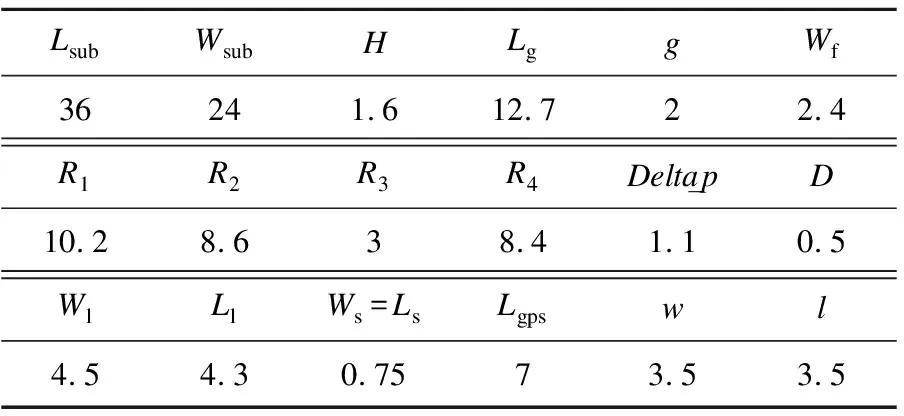
Table 1 Optimum parameters of antenna (mm)
2 Performance analysis
The original annular antenna broadens bandwidth by realizing dual-frequency resonance; however, it can realize UWB by further reducing the patch and cutting slots.Therefore, the distancegbetween annular patch and ground, the rectangular slot and stepped slots at the top of the left and right can realize impedance matching to broaden bandwidth of the antenna.The change curve of bandwidth is shown in Fig.3.
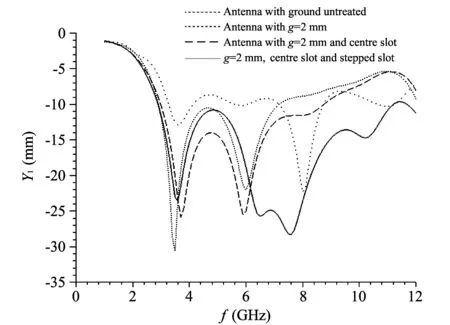
Fig.3 Change curve of original antenna bandwidth
The length of C-shaped slot isMC=25.7 mm, which is equal to half of the waveguide wavelength of WiMAX 3.5 GHz.The slot widthDelta_rand distancegcan affect notched characteristics in WiMAX wave band.
From Fig.4, we know thatDelta_rcan mainly affect the length of C-shaped slot.When the length of slot becomes longer, the notched centre frequency will become smaller, and the notched bandwidth becomes wider; but it has no effect on WLAN waveband.
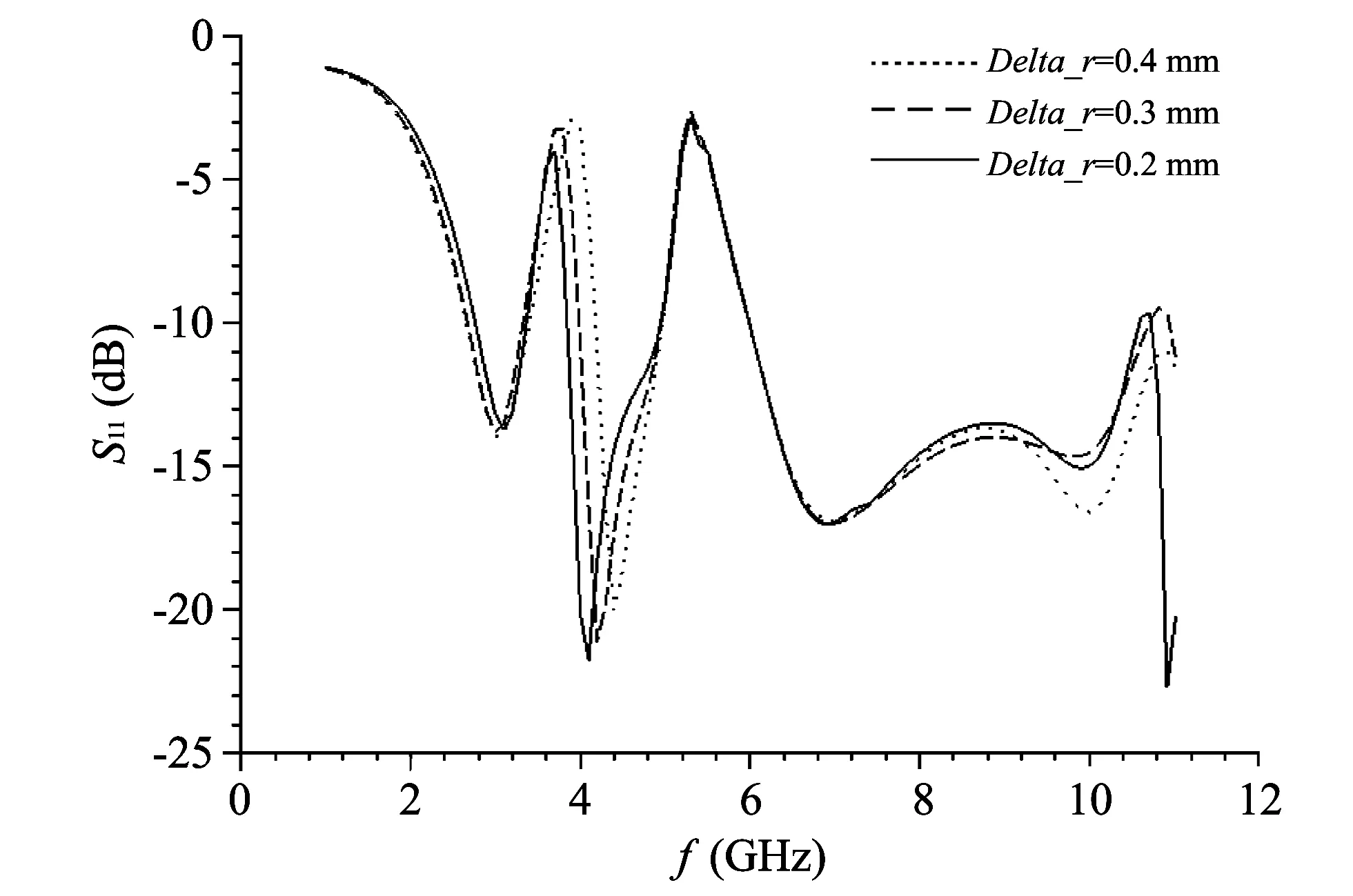
Fig.4 Impact of Delta_r on S11
Fig.5 shows that whengbecomes larger, the notched centre frequency of WiMAX becomes smaller, and bandwidth becomes smaller, too.Meanwhile,gwill affect notched bandwidth of WLAN apparently, and the notched bandwidth will shift left asgbecomes larger.The change curve ofghas a function of impedance matching.
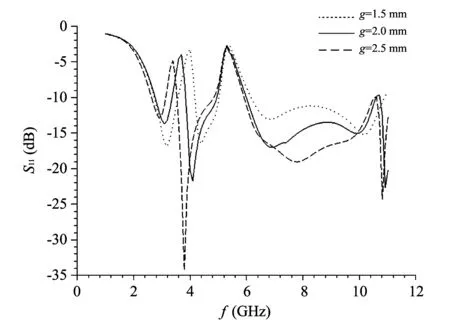
Fig.5 Impact of g on S11

Fig.6 Impact of l and w on S11
The length of L-shaped slot isML=8.425 mm, a quarter of wavelength of WLAN 5.5 GHz.The factors which mainly affect notched WLAN areg,Lgps,Wl,L-l,w,l,LsandWs.
Fig.6 shows thatlandwlead to obvious change of notched WLAN centre frequency and its bandwidth.Whenlremains changeless andwbecomes larger, the notched WLAN centre frequency becomes smaller, but the notched WiMAX is opposite.Whenwremains changeless,lbecomes larger, the notched WLAN and WiMAX centre frequencies become smaller.
Fig.7 shows that the width of L-shaped slot enormously affects notched WLAN frequency.When the bandwidth becomes larger, both the notched WLAN and WiMAX frequencies become smaller.
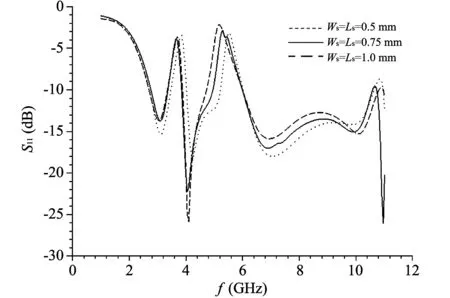
Fig.7 Impact of width of L-shaped slot on S11
From Fig.8, we know that the change ofLgpsaffects the two notched frequency.WhenLgpsbecomes larger, the notched WLAN bandwidth will become larger; when its centre frequency remains changeless, the notched WIMAX centre frequency will shift left.
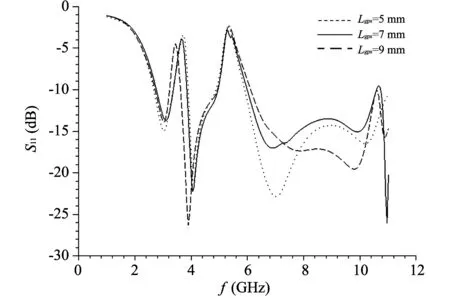
Fig.8 Impact of Lgps on S11
Fig.9 showsS11of the notched antenna.It can be seen that the bandwidth is 2.7-10.6 GHz whileS11<-10 dB, which meets the requirement of the frequency for UWB communication of 3.1-10.6 GHz.Between 3.2-3.8 GHz and 5.1-6 GHz,S11>-10 dB, and the impedance restraining is apparent, so the antenna has perfect notched characteristics.
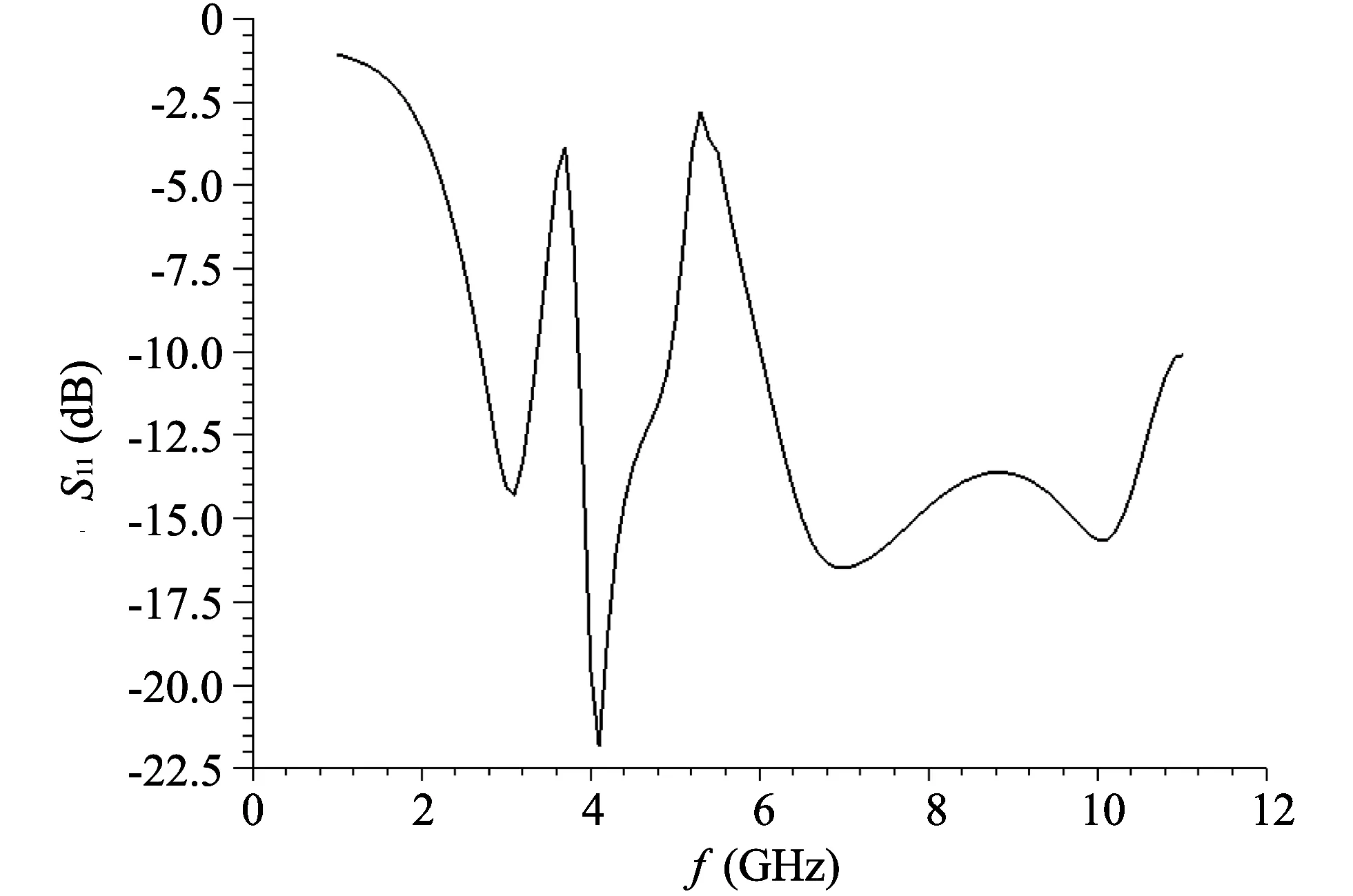
Fig.9 S11 of dual-band notched antenna
The antenna directivity simulation program is carried out at 3, 5, 7 and 10 GHz to analyze its directivity characteristics.From the following Figs.10-13, it can be known that the antenna has perfect directivity characteristics because it is almost omni-directional at Phi=90 °.
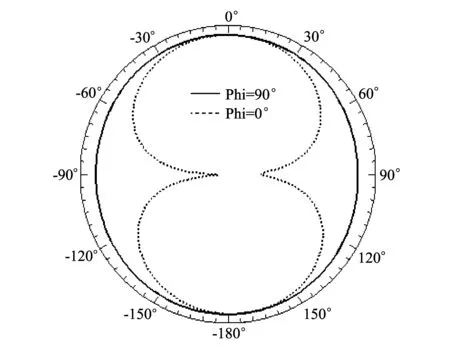
Fig.10 Directivity at 3 GHz
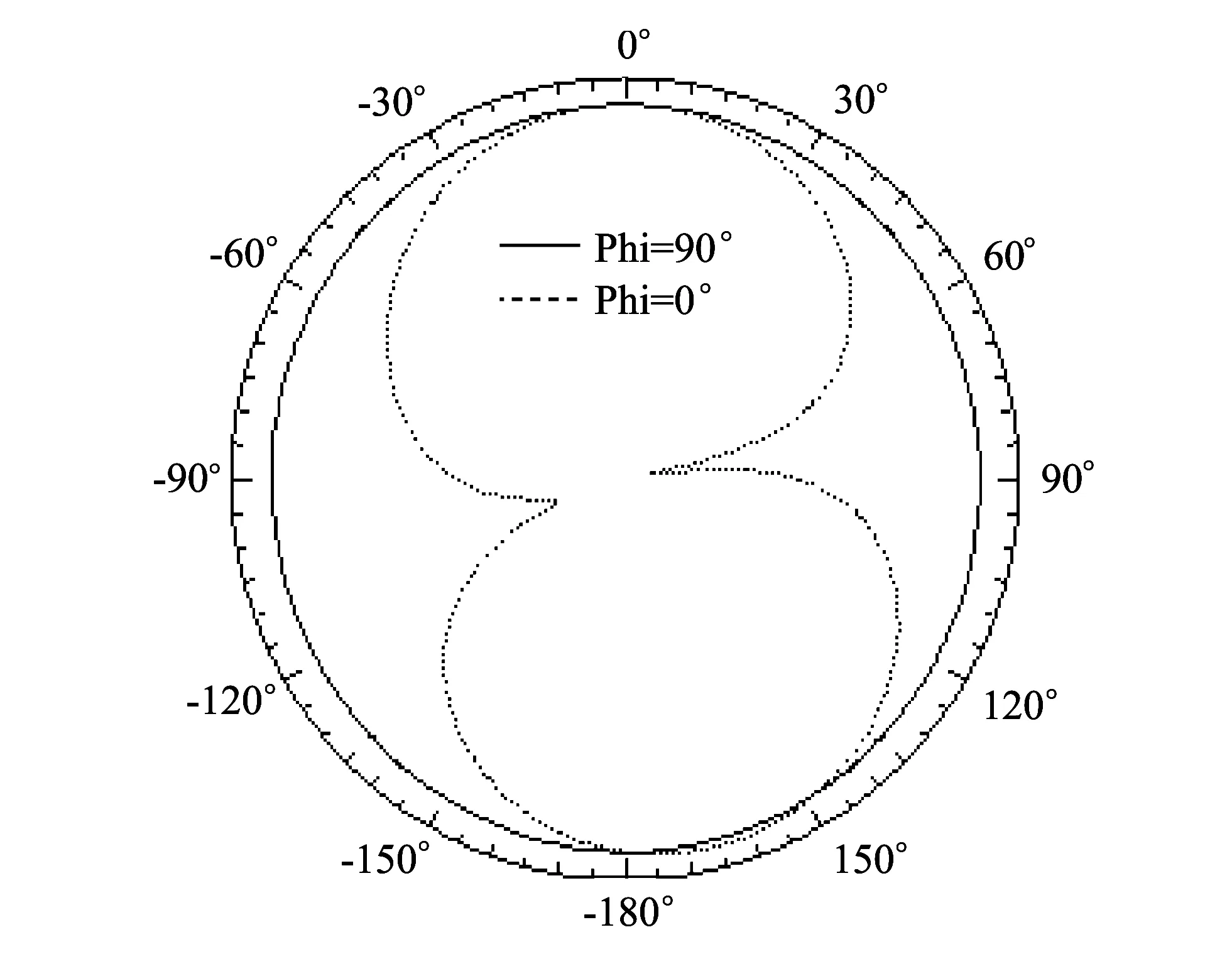
Fig.11 Directivity at 5 GHz

Fig.12 Directivity at 7 GHz
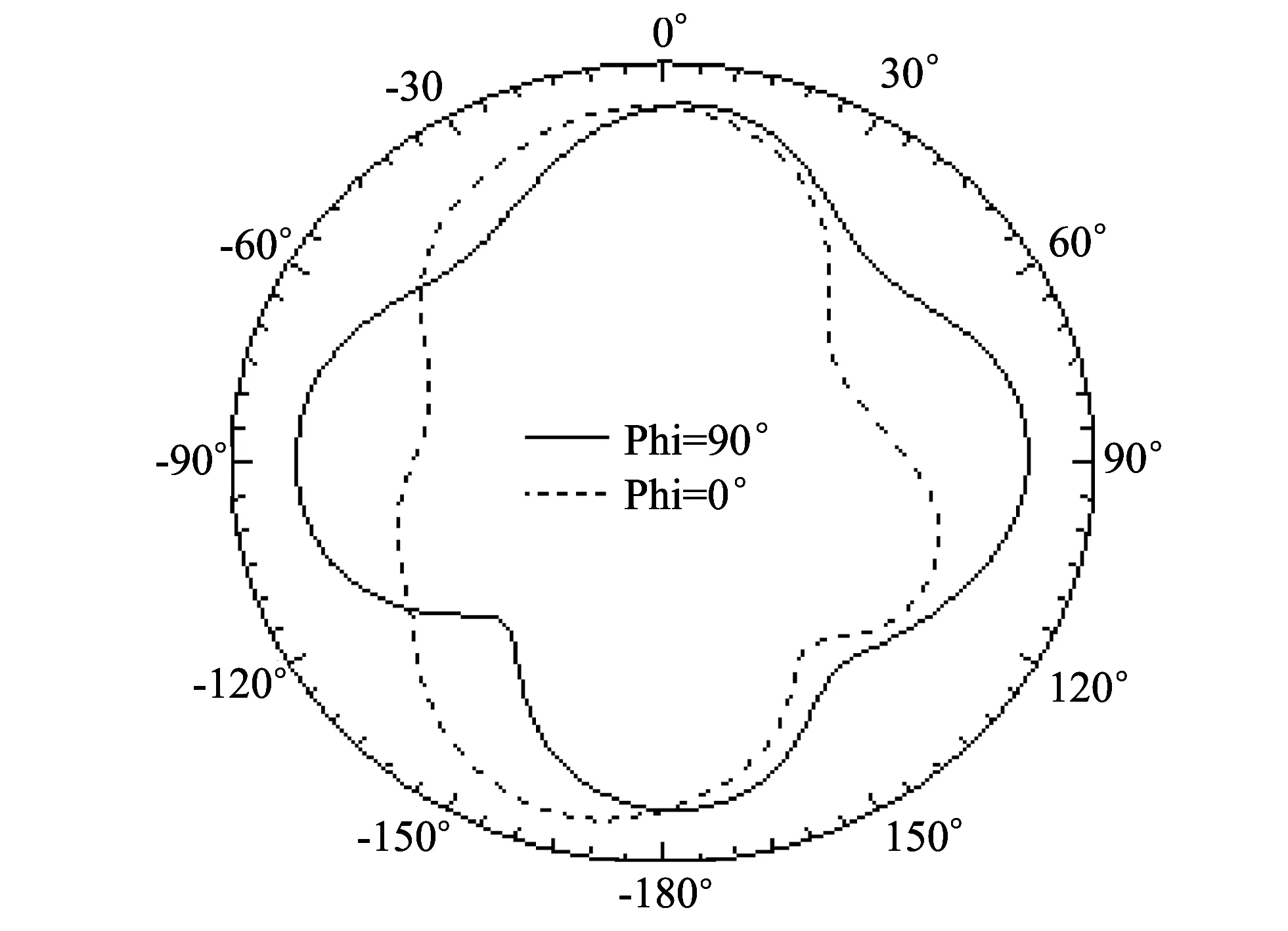
Fig.13 Directivity at 10 GHz
From Fig.14, it can be seen that the antenna has good gain, ranging from 1 dB to 4 dB in the whole efficient bandwidth except for two notched bandwidth, which can satisfy practical needs.Thus, it can been proved that the proposed antenna is effective and practical.
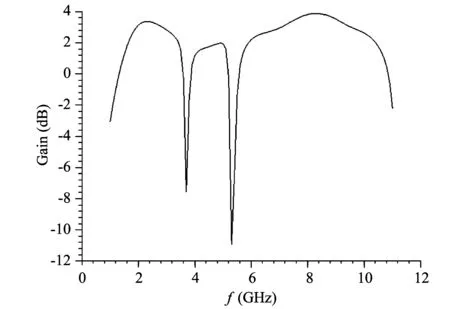
Fig.14 Gain of the antenna
3 Conclusion
A compact annular dual-band notched UWB antenna with low-cost and small-size is proposed.It realizes notched characteristics well between WiMAX 3.5 GHz and WLAN 5.5 GHz by cutting L-shaped slot on the ground and C-shaped slot on the patch.The bandwidth of 2.7-10.6 GHz withS11<-10 dB satisfies the need of UWB communications.The antenna has good directivity and radiation characteristics for it is almost omni-directional onYOZplane.Except 3.2-3.8 GHz and 5.1-6 GHz, it has favorable gain on the whole bandwidth, ranging from 1 dB to 4 dB, so the propsed antenna is efficient and practical.
[1] Mishra S K, Gupta R K,Vaidya A,et al.A compact dual-band fork-shaped monopole antenna for buletooth and UWB applications.IEEE Antennas and Wireless Propagation Letters, 2011, (10): 627-630.
[2] Nguyen T D, Lee D H, Park C.Design and analysis of compact printed triple band-notched UWB antenna.IEEE Antennas and Wireless Propagation Letters, 2011, (10): 403-406.
[3] ZHONG Shun-shi, LIANG Xian-ling.Progress in ultra-wideband planar antennas.Journal of Shanghai University, 2007, 11(2): 95-101.
[4] Mishra S K, Gupta R K, Vaidya A, et al.Low-cost,compact printed circular monopole UWB antenna with 3.5/5.5 GHz dual-band notched characteristics.Microwave and Optical Technology Letters, 2011, 54(1): 242-246.
[5] Liao X J,Yang H C- Han N, et al.A semi-circle-shaped aperture UWB antenna with triple band-nouched character.Journal of Electromagnetic Waves and Applications, 2011, 25(2/3): 257-266.
[6] YANG Ling-sheng,Yoshitomi K.A compact circular corner monopole antenna for UWB application.Micsowave and Optical Technology Letters, 2012, 54(1): 147-150.[doi:10.1002/mop.2646]
[7] Zolfagharian A R, Azarmanesh M N, Qjaroudi M.Ultra-wideband small square monopole antenna with variable frequency notch band characteristics.Microwave and Optical Technology Letters, 2012, 54(1): 262-267.
[8] Ebrahim H, Ghobadi Z C, Nourinia J.Circular multifractal UWB monopole antenna.IEICE Electronics Express, 2010, 7(10): 717-721.
[9] Klemm M, Craddock I J, Leendertz J A, et al.Radar-based breast cancer detection using a hemispherical antenna array experimental results.IEEE Transactions on Antennas and Propagation, 2009, 57 (6): 1692-1704.
[10] Lotfi P, Azarmanesh M, Abbaspour-Sani E, et al.Design of very small UWB monopole antenna with reconfigurable band-notch performance.In: Proceedings of the 4th International Symposium on Telecommunications, Tehran, Iran, 2012: 102-105.
[11] Gibbins D, Klemm M, Craddock I J, et al.A comparison of a wide-slot and a stacked patch antenna for the purpose of breast cancer detection.IEEE Transactions on Antennas and Propagation, 2010, 58(3): 665-673.
 Journal of Measurement Science and Instrumentation2014年1期
Journal of Measurement Science and Instrumentation2014年1期
- Journal of Measurement Science and Instrumentation的其它文章
- Error separation in CMM coordinate metrology
- Design and theoretical analysis of test system for propellants’ gas pressure in warhead
- A new probe for atmospheric electric field mill
- Experimental analysis of high temperature capacitance variance of MLCC
- Application of RLS adaptive filtering in signal de-noising
- QIM digital watermarking based on LDPC code and message passing under scaling attacks
